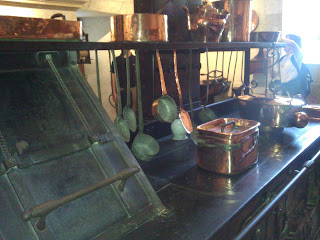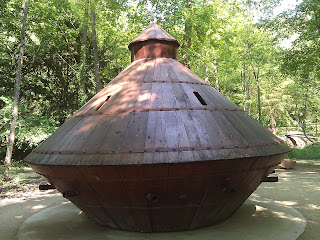...As Marie Antoinette was fabled to have said during the French Revolution (not "Let them eat cake"). And eating brioche we have been, among other goodies.
All the delicious eats make the weather worth it. Especially yesterday, when it was rainy, cold and windy all day. We learned our lesson from Sunday's rain-filled adventures that it is better to wear sandals and have occasionally freezing toes than to wear tennis shoes and walk around in wet socks all day.
Yesterday we covered a lot of ground in terms of landmarks and museums. We started off the day with a 20-minute rain-soaked walk to Notre Dame. By the time we arrived, we were hungry, wet and a little irritable. All negative emotions were quickly wiped away when we saw a big tent in front of the cathedral with this title:
 |
| My kind of party. |
The translation meaning, "Festival of Bread" or "Bread Party." I'm going to go with "Bread Party." Inside was a magical land full of bakery demonstrations, artistic creations using pastry and bread and most importantly, items for sale. Surveying the array of croissants, tartines and pastries before us, we finally selected a hefty chocolate chip brioche to share. It was buttery, soft and heavenly, and helped brace us for the cold, rainy minutes that followed as we waited in line to get into Notre Dame.
 |
| Inside Notre Dame. |
We joined the throngs of tourists moving as quietly as we could through the funeral mass taking place inside. We admired the huge proportions and beautiful statues and stained glass, especially the "rosaces," or rose windows. After our circuit around the cathedral was completed, we reluctantly headed back out into the rain and the cold. We cut through the Bread Party again, mostly for the warmth and good smells, and grabbed a couple of samples of something sort of like cornbread for the road.
 |
| There was also this massive narwhal tooth. |
Our next stop was the Cluny Museum of the Middle Ages in the Latin Quarter. The museum itself is built on top of an ancient Roman-style bathhouse. There were a lot of neat artifacts inside, including one of many solid gold roses the Avignon popes used to hand out as special awards. The most famous artworks inside this museum, however, are the unicorn tapestries--"La Dame a la Licorne." They are six 15th century tapestries that have survived the ages surprisingly well. Five of them show a lady interacting with a unicorn and a lion and each demonstrate one of the five senses. The sixth shows a lady outside of a tent bearing the inscription, "To my only desire." Part of the reason for the notoriety of these tapestries is their mysterious nature, as nobody quite understands what they mean.
 |
| Ceiling with trinkets. |
After the Cluny, we stopped for lunch at nearby restaurant, that was admittedly chintzy and meant for tourists, but interesting, cheap and surprisingly delicious. The walls were covered with mosaics of Greek seascapes and the ceiling with red lightbulbs and an assortment of dangling trinkets. Most importantly for our purposes, it was warm and dry and they served food. But our meal was really good, and only 12 euros apiece.
The day becoming even colder and wetter, we decided to give the nearby Luxembourg Gardens a miss. We gratefully ducked into the nearest Metro to ride out to the Centre Pompidou, the modern art museum named after Georges Pompidou, president of France from 1969-1974. It is one of the few major Parisian museums I have never visited, but I'm glad we went to see it. After a whole trip full of Renaissance and classical art, we were ready for a change: namely, art that had a wider variety of topics than Biblical or historical scenes. The museum itself is fascinating, built to look sort of inside-out, with its escalators on the outside. We walked through displays of all kinds of art from the 20th century, from cubism and dadaism to more recent, post-modern works. Though I tend to prefer modern art, I must admit that some of it makes me question the talent and integrity of the so-called artist. For example, we saw one canvas that was painted a uniform navy blue. That was it. Just one shade for the whole thing. Next time I need someone to paint a room in my house, I'll call that guy. On the other hand, we saw some truly neat pieces. Some favorites are shown below:



Once we had decently covered the Pompidou, we grabbed the Metro back to the hotel to rest our feet and remember what it was like to be warm and dry. For dinner, we walked a block away to Fuxia, the Italian restaurant where we had had such wonderful desserts the night before, and enjoyed some bruschetta, lasagna and rigatoni. On a cold day, there's nothing like pasta to warm you up.
 |
| Place des Vosges. |
Thankfully, the rain held off today, though it was still cool and cloudy until the afternoon. We began the day at nearby Angelina, named the best bakery in the first arrondissement, and indeed it was fantastic. I've eaten a lot of pain au chocolat (croissants with chocolate in the middle) in my day, but this one was exceptional. Eating on the way, we hopped on the Metro out to the Marais for our Paris Walks walking tour. Along with a couple dozen other English-speaking tourists, we walked and listened as our tour guide, an engaging and knowledgeable British woman named Oriel, told us about the history of various mansions, churches and houses in the area. The Marais, which is the French word for "marsh," was essentially that and not much else until the 15th century when it became fashionable to build country mansions there. It became an even more popular place for the nobility in the 17th century, when Henri IV oversaw the construction of the Place des Vosges, the oldest square in Paris where many courtiers built residences to be close to the king.
 |
| Oriel, our guide, in the Hotel de Beauvais |
In more recent times, the Marais has housed the Jewish community of Paris, as immigrants from Eastern Europe who spoke only Yiddish were able to find work and housing there. As such, there are many kosher shops and falafel stands, as well as monuments commemorating the Holocaust. Learning about the history of this charming district was really fascinating, and I would recommend it for anyone coming to visit Paris.
 |
| So good. |
Right after our tour was over, we booked it a few blocks away to the rue des Rosiers, the location of the famous L'As du Fallafel (meaning "Falafel Champion"), where we enjoyed what might possibly be the best falafels on the planet. Fried chickpea patties in a pita stuffed with cabbage and cucumber slaw, eggplant and yogurt sauce. Salivating yet? I am just thinking about it.
 |
| One of Polaine's 3 locations. |
So this is how our little foodie pilgrimage began. Since we'd done our bit of history for the day, and since lots of museums are closed on Tuesdays, we journeyed to a couple of food-related destinations. I suppose the Angelina bakery this morning counted as the first stop, L'As du Fallafel the second. We did Berthillon ice cream next, having a couple of scoops at a nearby cafe. After that, we followed the winding rue Debelleyme to one of the Polaine bakeries; as in Lionel Polaine, a French artisanal baker who became famous for returning to traditional methods of bread-making. Still full of our lunch, we split a small 6-inch loaf just to have a taste of the magic.
 |
| The aromas inside this place... |
We continued our pilgrimage, somewhat off the beaten path, headed all the way up north of the Place de la Republique to one of the top three patisseries in Paris, a little old-fashioned bakery called "Du Pain et des Idees," or "Of Bread and Ideas." Very quaint. We split a sacristain, which is basically a twist of flaky pastry dough with a vanilla sort of custard. It sounds like non-stop eating, but remember we were doing a lot of walking from place to place.
 |
| No room in my suitcase. |
From deep into the 3rd arrondissement we walked all the way through the 2nd and into the 1st, where we stopped at Mora, the cookware store where many leading French chefs are said to shop. We poked around all the gadgets, pots and pans and pastry molds, including several types of Eiffel Tower cake pans.
These were tempting. Finally feeling the effects of walking and eating all day long, we made our way back to the hotel where I took a pre-dinner nap. Of course, we weren't even hungry until about 8pm. But when we finally did feel our tummies rumbling, we headed over to the rue des Petits Champs, where we ate dinner our first night here, to dine at the famous Willi's Wine Bar. A tad pricey for young people on a budget, but since it was our last night we splurged. And it was worth it. My asparagus salad, guinea fowl and chocolate mousse was one of the best meals I've had this whole trip, which is saying something.
Tomorrow we will rise early and head to the airport, where I will put John on a plane home and meet my parents, who will have just arrived. From there the three of us will hop on a train south to the Loire Valley. So ends one chapter of the trip and begins another. I'm sure more history and good food will follow.





















































